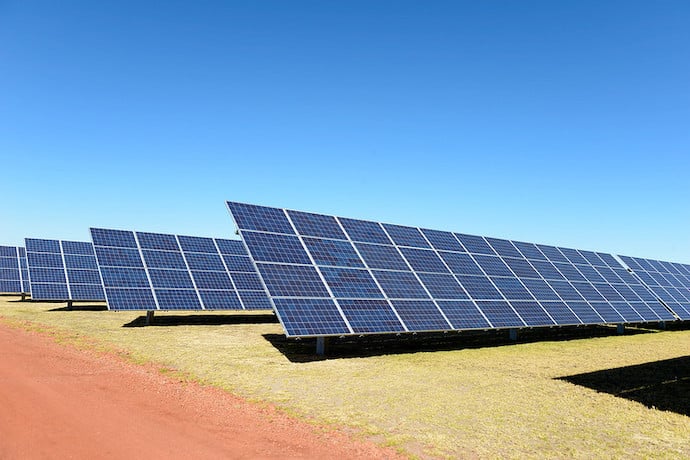Many of us dream of saving the world, but few of us create a computer model showing how to do it.
Meteorologist Eugenia Kalnay has created a plan to build large-scale wind and solar farms in the Sahara Desert. The idea was that farms would provide energy for the world, and, Kalnay was pretty sure they would stop desertification of the Sahara.
Kalnay, who is a professor of distinction at the University of Maryland, explained that the idea of using the Sahara started at Massachusetts Institute of Technology back in 1975.
In a non-desert ecosystem, such as a forest, dark soil and vegetation collects the heat from the sun during the day. At night, the heat rises up and into the atmosphere. The atmosphere gives up the moisture and rains.
In 1975, Kalnay’s advisor Jule Charney described the feedback loop that leads to desertification: Drought creates pale soil. Light colored soil reflects the sunlight back up without heating up the ground. There is less heat released into the air. Air is no longer driven up to higher levels of the atmosphere, which, no longer gives up moisture. Less precipitation means the remaining vegetation dies and the whole process increases.
The roughness, or friction, of the ground is also important in the movement of the air and is part of another feedback loop, which was described in 1985 by Y.C. Sud. This is where Kalnay came in. “About ten years ago, I had the idea that this feedback would work in the opposite direction in the presence of the large arrays of solar panels and wind turbines,” she said.
Kalnay’s idea is that dark solar panels would act as dark soil and heat the air, and the wind farm would help create friction and move the warm air up.
The idea sounded good but she needed someone to build a complex computer model to test it.
A computer model is a computer program designed to show what might happen in a given situation. A simple weather model might start with the temperature taken in your town every day for a year. The model would use then use that data to start to predict future weather.
Of course weather is more than temperature. Kalnay needed other experts who knew how the Sahara worked, as well as someone to build the model. She assembled a team of seven and they looked at normal weather predictions, the interactions of the wind, the sun, the change in the ground cover and resulting changes to the local ecosystems. Then they ran the model.

“I was totally delighted,” Kalnay said. “It was exactly what I hoped would happen.”
What she and her team showed was that large-scale wind and solar farms in the Sahara Desert could provide enough electricity to power the world, and also bring rain back to the sub-Saharan region that is suffering from drought.
The team published an article in Science Magazine September 2018. Their paper proposes a system that would solve the world’s energy needs. In the model, the Saharan desert array of solar and wind turbines would be on a swath of land as large as the continental United States. The energy production would be four times the current world usage.
Equally thrilling was the fact that the array would help stop desertification.

“Our model results show that large-scale solar and wind farms in the Sahara would more than double the precipitation in the Sahara,” said Li, who has since moved back to China.
When the study came out, Kalnay fielded questions about whether this project was science fiction. She answered that it would only be science fiction if the technology didn’t already exist. But, she pointed out, the systems are out there and do work.
Their paper was named as one of the top 100 science papers of the year.
Kalnay, who is originally from Argentina, hopes the project can give people a direction in their work to save the planet. “We can stop the source of climate change,” she said. “And we can provide more resources for people in the poorest region in the world.”
Learn More
Eugenia Kalnay
https://en.wikipedia.org/wiki/Eugenia_Kalnay
Kalnay receives Roger Revelle medal
https://eos.org/agu-news/eugenia-kalnay-receives-2019-roger-revelle-medal
Desertification and climate change
https://www.carbonbrief.org/explainer-desertification-and-the-role-of-climate-change
Desertification
https://earthobservatory.nasa.gov/features/Desertification/desertification2.php
Solutions to desertification
https://www.bbc.co.uk/bitesize/guides/zctymnb/revision/5
Causes, effects and solutions for desertification
https://www.conserve-energy-future.com/causes-effects-solutions-of-desertification.php
What’s behind desertification?
https://www.prb.org/whatsbehinddesertification/
Make the Sahara Green Again
https://www.livescience.com/63556-wind-solar-farms-rain-sahara-desert.html
Solar and Wind Farms in the Sahara
Will the US be a desert in 50 years?
https://science.howstuffworks.com/nature/climate-weather/atmospheric/us-desert-50-years1.htm
World Day to combat desertification
https://www.un.org/en/observances/desertification-day
Children fight desertification
https://www.youtube.com/watch?v=UuwpX8qeNXo
Desertification
http://encyclopedia.kids.net.au/page/de/Desertification
What can kids do about climate change?
https://www.climaterealityproject.org/blog/just-kids-what-climate-change-and-what-can-i-do

